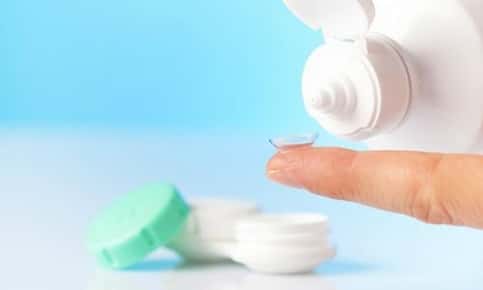
How Often Should I Change My Contact Lens Case?
Wet, dark contact lens cases provide the perfect breeding ground for bacteria and fungi. Fortunately, you can avoid painful eye infections by replacing your cases regularly and following your optometrist's lens and case care instructions.
Replace Every 3 Months
No matter how carefully you clean your contact lens case, it may still harbor bacteria, viruses, or fungi. The problem is caused by an invisible bacteria-laden coating called a biofilm. The film forms on the wells and lids of the case and may still be present after you clean or soak your case.
The American Optometric Association recommends replacing contact lens cases every three months to reduce your risk of infection. Some contact lens manufacturers suggest replacing the cases as often as every one to two months.
According to an April 2011 article in Review of Cornea and Contact Lenses, 30% to 85% of contact lens cases eventually become contaminated. Unfortunately, the contact lenses stored in the cases can become contaminated too, increasing the chance that you'll develop an infection.
Infections can cause corneal ulcers, painful sores that form on the surface of your cornea. The cornea is the clear layer of tissue that covers your iris and pupil. Severe infections can scar or cloud the cornea, permanently altering your vision.
If you develop a corneal ulcer, you may experience:
- Pain
- Discharge or Pus
- Redness
- Tearing
- Foreign Body Sensation
- Sensitivity to Light
- Itching or Burning
Stop wearing your contact lenses and call your eye doctor immediately if you notice any of these symptoms. Prompt treatment will help you avoid serious damage to your corneas or loss of vision.
Contact Case Care Recommendations
Following these guidelines can decrease your infection risk:
- Always Wash Your Hands. Wash your hands every time you touch your contact lenses or your lens case, even if you just washed your hands 15 minutes earlier.
- Don't Use Water to Clean Your Case or Store Your Contacts. Using tap water can increase the risk of contamination.
- Use Fresh Solution for Cleaning. Dump out your old contact lens solution daily and clean the wells and lids of the case with fresh solution. Be sure to follow the manufacturer's specific recommendations for case cleaning.
- Don't Top Off the Solution: Adding a little contact lens solution every day may help you conserve solution, but it could compromise your vision. Although the old solution might look fine, it could contain bacteria, fungi, or parasites.
- Air Dry Your Contact Lens Case. Air drying is the best way to dry your contact lens case. After cleaning the case, turn it upside down to ensure that no solution remains in the wells.
- Keep Your Cleaned Case Out of the Bathroom. The bathroom may seem like the perfect place to air dry your case, but you may unwittingly contaminate it if you leave it on the bathroom sink or counter. Flushing the toilet can propel tiny drops of bacteria many feet from the toilet, contaminating your contact lens case and other surfaces. Although closing the lid before you flush can be helpful, some bacteria may still escape.
- Replace Damaged or Dirty Cases Immediately. Don't try to clean cases that are noticeably dirty. Although they may look cleaner after you rub away the spots, bacteria or fungi will probably still be present. Throw away damaged or cracked cases immediately. Even small cracks in your case can allow bacteria to enter.
Proper cleaning and care of your contact lens cases can help you avoid infections. Contact us if you think you may have an infection, or it's time for your next vision exam.
Sources:
American Optometric Association: Contact Lens Case Care
https://www.aoa.org/patients-and-public/caring-for-your-vision/contact-lenses/case-care
Review of Cornea and Contact Lenses: What is Happening in Your Contact Lens Storage Case?, 4/18/11
http://www.reviewofcontactlenses.com/article/what-is-happening-in-your-contact-lens-storage-case
WebMD: Contact Lenses and Eye Infections
https://www.webmd.com/eye-health/contact-lenses-eye-infections#1
American Academy of Ophthalmology: How to Take Care of Contact Lenses, 9/9/18
https://www.aao.org/eye-health/glasses-contacts/contact-lens-care